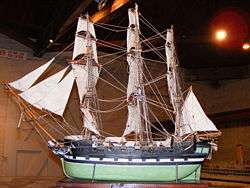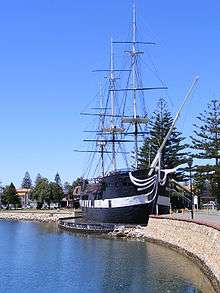HMS Buffalo (1813)
HMS Buffalo was a storeship of the Royal Navy, originally built and launched at Sulkea, opposite Calcutta, in 1813 as the merchant vessel Hindostan. The Admiralty purchased her that year after she arrived in Britain. She later transported convicts and immigrants to Australia, before being wrecked in 1840.
 1936 model of Buffalo | |
| History | |
|---|---|
| Name: | HMS Buffalo |
| Builder: | James Bonner & James Horsburgh, Sulkea[1] |
| Launched: | 4 January 1813 as Hindostan |
| Acquired: | 22 October 1813 by Royal Navy |
| Refit: |
|
| Fate: | Wrecked in Mercury Bay, 28 July 1840. |
| General characteristics [2] | |
| Class and type: | sixth-rate storeship |
| Tons burthen: | 589,[3] or 670[1] (bm) |
| Length: |
|
| Beam: | 33 ft 6 in (10.21 m) |
| Depth of hold: | 15 ft 8 in (4.78 m) |
| Propulsion: | Sail |
| Sail plan: | Full rigged ship |
| Complement: |
|
| Armament: |
|
| Notes: | Water buffalo figurehead |
Launch and purchase
Hindostan was built of teak by James Bonner and James Horsburgh, of Firth, in 1813 at Sulkea, on the Hoogly near Calcutta.[2][3] The Calcutta Gazette, reporting on her launch, described her as a merchantman built to carry grain rice. Her hull was pierced at the upper deck to be able to carry 20 guns, and she measured about 578 tons burthen.[5]
In August 1813, after a six-month maiden voyage, Hindostan arrived in the East India Dock, London to discharge and was offered for sale.[5] She had left Bengal on 18 February, passed the Point de Galle on 13 March, stopped at St Helena on 9 June, and arrived at The Downs on 10 August.[1]
The Lords Commissioners of the Admiralty purchased her on 22 October. David Webster, representing the builders, brokered the sale price of £18,000 for Hindostan.[2] The Navy Board renamed her HMS Buffalo, designated her a sixth rate, and employed her as a storeship.
The Navy Board also purchased the similar Severn (550 tons burthen), that it renamed HMS Camel. Horsburgh had part-financed the building of both Severn and Hindostan in the partnership of Horsburgh & Colman.
Royal Navy service
Buffalo was commissioned in November 1813 under Mr. Richard Anderson, Master,[6] and became a ship of many uses and refits. Anderson was still her master between 1814 and 1815 when she was stationed at the Army Depot at Bermuda.[7] Then in January 1816 Mr. W. Hudson became master.
Buffalo was at Deptford in 1822, 1827, and 1831.[7] She was fitted as a timber carrier to carry spars from New Zealand in 1831.[6] However, she apparently was in the Quarantine Service at Stangate in 1832.[7]
Then in January 1833 she was fitted as a convict ship,[6] and F.W.R. Sadler took command.[7] Buffalo sailed to Australia 12 May 1833 and arrived on 5 October 1833.[8] She carried 180 female convicts, one of whom died on the journey.[9]
Buffalo was an important ship in the maritime history of South Australia, serving at times as a quarantine, transport or colonisation ship, while also aiding the British expansion into New Zealand, New South Wales, Tasmania, and Upper Canada. Sadler received gifts from the local Maori chief of Tītore in the Bay of Islands during one of HMS Buffalo's trips. The gifts included a pin, a club, and an ornate Hei-tiki, all now in the British Museum.[10]
Buffalo was paid-off and recommissioned in January 1835. Then James Wood took command in July 1836. Buffalo sailed from Portsmouth on 23 July 1836, arriving in South Australian waters in December of that year, carrying 176 colonists, including Captain John Hindmarsh, who was to become the first Governor of the new colony of South Australia following the proclamation of that colony on 28 December 1836. Other passengers on HMS Buffalo to South Australia in 1836 included: James Cock, Robert Cock (James father), William Ferguson, Osmond Gilles, Charles Beaumont Howard, Young Bingham Hutchinson, and brothers Giles E. Strangways, Thomas Bewes Strangways and Frank Potts (winemaker).
Only three deaths were ever recorded on Buffalo,[11] a remarkable record considering the medical practices of that period and volumes of passengers she transported.
S. Hindmarsh may have been captain in 1837 but James Wood returned to command and would remain her captain until her loss.
Wood next sailed Buffalo to Quebec with 300 soldiers as reinforcements for the British forces dealing with the Rebellions of 1837 there. On 28 September 1839 she sailed from Quebec, Canada with 82 American patriots and 58 French prisoners from Lower Canada who were convicts and part of the Upper Canada Rebellion. On 12 October a conspiracy to murder the ship's crew was attempted, but was discovered, and the rebels secured. The mutiny was reported in the Morning Chronicle on 22 November, and much later in the Sydney Herald on 22 April 1840.[12] The Americans were transported to Hobart, Tasmania and the French convicts were brought to Sydney, New South Wales.[13]
She was fitted as a timber carrier again in 1839.
Fate
Buffalo was anchored in Mercury Bay off Whitianga and loaded with Kauri spars when a storm on 28 July 1840 wrecked her. The gale parted her from her cables. When it became clear that her crew could not save her, Wood steered her onto the beach. All the crew except two were saved, but she herself was a total loss.[14]
Post-script
The tsunami of 22 May 1960 briefly exposed the wreck as water retreated. People who ran out to see it had to retreat again as the sea level returned to normal.[15]
A team of maritime archaeologists and volunteer divers led by the South Australian Government’s State Heritage Branch located the wreck site in April 1986.[16][17][18] The wreck of HMS Buffalo is still visible today at Buffalo Beach off Whitianga. The wreck is only visible from the air at low tide and in clear water conditions. The GPS co-ordinates for the location of the wreck are 36°49′36.20″S 175°42′20.0″E.
In 2009 the Deployable Hydrographic Survey Unit of the Royal New Zealand Navy located the wreck using side-scan sonar and dived on the wreck using snorkels. Much of the wreck has been broken up by storms with the remaining timbers of the hull still in solid condition despite over 150 years in the ocean.[19]
The wreck has been charted by Land Information New Zealand.[20]
Replica

As a tribute, a static replica of Buffalo was built in 1980 on the shore of the Patawalonga River at Glenelg, a suburb of Adelaide, as a restaurant and museum. It was based on the original Admiralty specifications and plans, with some internal modifications (eg higher clear deck height).[21][22] After a period of financial difficulties, the venture was closed and the vessel deteriorated. Despite large-scale redevelopment plans the City of Holdfast Bay announced in January 2019 that the replica would be demolished.[23]
Citations and references
Citations
- British Library: Hindostan (3).
- Sexton 1984, pp. 11–12
- Stringer 1980, p. 6
- Sexton 1984, p. 27
- "The Ship HINDOSTAN". Public Ledger and Daily Advertiser (16533). London: The British Newspaper Archive (subscription required). 25 August 1813. p. 4. Retrieved 3 February 2019.
- Winfield (2008), p. 398.
- "NMM, vessel ID 381491" (PDF). Warship Histories, vol v. National Maritime Museum. Archived from the original (PDF) on 2 August 2011. Retrieved 30 July 2011.
- Bateson (1959), pp. 302–3.
- Bateson (1959), p. 334.
- British Museum Collection
- Sexton 1984, p. 10
- "INDIAN NEWS". The Sydney Herald. New South Wales, Australia. 22 April 1840. p. 2 (Supplement to the Sydney Herald). Retrieved 11 April 2020 – via Trove.
- Convicts to Australia. http://members.iinet.net.au/~perthdps/convicts/canadian.html Accessed 8 March 2015.
- Hepper (1994), p. 163.
- de Lange, Willem; McSaveney, Eileen (13 July 2012). "Tsunamis - 20th-century tsunamis". Te Ara - the Encyclopedia of New Zealand. Retrieved 16 August 2015.
- (Adelaide) Advertiser, 9 April 1986, p.12.
- (Adelaide) Advertiser, 17 April 1986, p.10.
- Jeffery (1989), pp. 43–45.
- SLT Lester, Michael (December 2009). "Mercury Bay Survey: Identifying HMS Buffalo" (PDF). Navy Today p.29. Retrieved 16 February 2014.
- "NZ 5316 - Whitianga Harbour". NZ Marine Chart. Land Information New Zealand. Retrieved 20 December 2018.
- Painter, Alison. "14 June 1837 HMS Buffalo". Discover South Australia's History. Rundle Mall, South Australia: Professional Historians Association (SA). Archived from the original on 25 March 2018. Retrieved 3 February 2019.
- "HMS Buffalo Replica". Glenelg, South Australia: The Buffalo Restaurant. Archived from the original on 6 September 2018. Retrieved 3 February 2019.
- Boisvert, Eugene; McLoughlin, Chris (30 January 2019). "Buffalo replica to be demolished". ABC News. Retrieved 3 February 2019.
References
- Bateson, Charles (1959). The Convict Ships. Brown, Son & Ferguson. OCLC 3778075.
- Colledge, J. J.; Warlow, Ben (2006) [1969]. Ships of the Royal Navy: The Complete Record of all Fighting Ships of the Royal Navy (Rev. ed.). London: Chatham Publishing. ISBN 978-1-86176-281-8.
- Hepper, David J. (1994). British Warship Losses in the Age of Sail, 1650–1859. Rotherfield: Jean Boudriot. ISBN 0-948864-30-3.
- Sexton, Robert (1984), H.M.S. Buffalo: An Account of His Majesty's Ship Buffalo, Naval Storeship and Timber Carrier, Quarantine Ship, Transport, and Emigrant Ship Bringing the First Governor to South Australia, Magill: Australasian Maritime Historical Society, ISBN 0-9591317-0-1
- Stringer, Myra (1980), Family history of John William and Susanna Adams, Adelaide: M. Stringer, ISBN 0-9594363-0-8
- Stringer, Myra (1986), Adams Family History 1774–1986, Adelaide: M. Stringer, ISBN 0-9594363-1-6
- Winfield, Rif (2008). British Warships in the Age of Sail 1793–1817: Design, Construction, Careers and Fates. Seaforth Publishing. ISBN 978-1-86176-246-7.
- (Adelaide), Advertiser (9 April 1986), SA team seek Buffalo wreck
- (Adelaide), Advertiser (17 April 1986), Divers find parts of the Buffalo
- Jeffery, W. (1989), Report on survey of HMS Buffalo wrecksite (1813-1840): Bulletin of the Australian Institute for Maritime Archaeology, Australian Institute for Maritime Archaeology
External links

- Pioneers and Settlers - Bound for South Australia HMS Buffalo 1836
This article includes data released under a Creative Commons Attribution-ShareAlike 3.0 Unported UK: England & Wales Licence, by the National Maritime Museum, as part of the Warship Histories project.